Aoralscan 3 Wireless by Shining 3D is one of the most popular intraoral scanners (IOS) from China. It is a scanner I have been asked to review countless times, and I am glad to (finally) be able to share this with you.
I have already reviewed the non-wireless version, and now that the company has released a huge software upgrade, it seemed like the right time to revisit this scanner and discuss what’s new and how it fits in the current IOS market.
The Aoralscan 3 Wireless was released on the 12th of September 2021. It is another affordable, scanner-only device but comes with much better software than most Chinese scanners we have reviewed, in fact, better software than many mainstream scanners outside of China, too.
I have used this scanner for over a year and it’s interesting to see how much the company has developed it. It reminds me of Medit and the constant upgrades that happened with that scanner when they were making a splash on the scene.
The team at iDD is fortunate to receive one of the first Aoralscan 3 units in New Zealand and the entire Oceania region. The following review goes over our experiences and how this scanner compares to all others on the market.
You can watch our review below, or keep reading for a more in-depth look.
Shining 3D Company Background
Shining 3D is not a newcomer to dentistry like many other emerging IOS companies. The company was founded in 2004 and developed its own 3D digitizing and additive manufacturing technologies, owning over 300 patents and more than 100 copyrights. It has more than 17 years of experience in the high-precision 3D digital products industry, which shows in many aspects, such as its software development.
Shining 3D provides fully integrated 3D digital dental solutions, from obtaining 3D data with 3D scanners for lab and intraoral 3D scanners for clinics to 3D printers.
In 2018, the company released its first dental DLP printer, the AccuFab-D1 (which they upgraded recently as the AccuFab-Cel), and in 2019, they released their first intraoral scanner, the Aoralscan.
Their first intraoral scanner left a lot to be desired. It was nowhere near close to the competition. Since 2019 the company has released two developments of their intraoral scanner, the Aoralscan 2 and Aoralscan 3.
The Aoralscan 3, released on 12th September 2021, is actually a very decent intraoral scanner with fast scan speeds, good accuracy, and an intelligent AI. It is also under 11,000 USD. You can read my review on that one here.
Following the market trend of wireless scanners, the company released the Shining 3D Aoralscan 3 Wireless in March 2023 (they also released the Metismile Face scanner on the same day). This wireless version is exactly the same as the non-wireless scanner. Since last year however, Shining 3D has also launched a huge upgrade to their scanning software.
So how does this scanner compare to other scanners dominating the low-cost scanner space? Let's go over it all.
You can view our unboxing of the Aoralscan 3 Wireless below!
Disclaimer - no conflict of interest. This is an objective review of the Aoralscan 3 Wireless intraoral scanner. The team at iDD remains unwaveringly committed to providing you with impartial and trustworthy information. Shining 3D had no part in writing this review or restricting any conclusions iDD makes in our thorough analysis and clinical use of these products.
Enjoy the unbiased review of the Shining 3D Aoralscan 3 Wireless by iDD.
Review at a Glance
The Aoralscan 3 wireless intraoral scanner is one of the best scanners from China and easily in the top 5 of all newly released intraoral scanners. It is the most affordable wireless intraoral scanner at 14,000 USD and the software has been totally improved over the past 12 months. For those who want a low cost wireless option, you should give it a try. This scanner is competing with market leaders such as TRIOS 5 and Medit i700 wireless at a lower cost entry point.
Pros:
Cons:
Aoralscan 3 Wireless Scan Speed
Like its predecessor, the Aoralscan 3, the wireless intraoral scanner is a high-performance scanner. It is very fast and provides a smooth scanning experience.
I consider it to be one of the best Chinese scanners on the market, if not the best one. The scanning process is efficient, and the AI is excellent. The AI filter soft tissue very well that may get in the way.
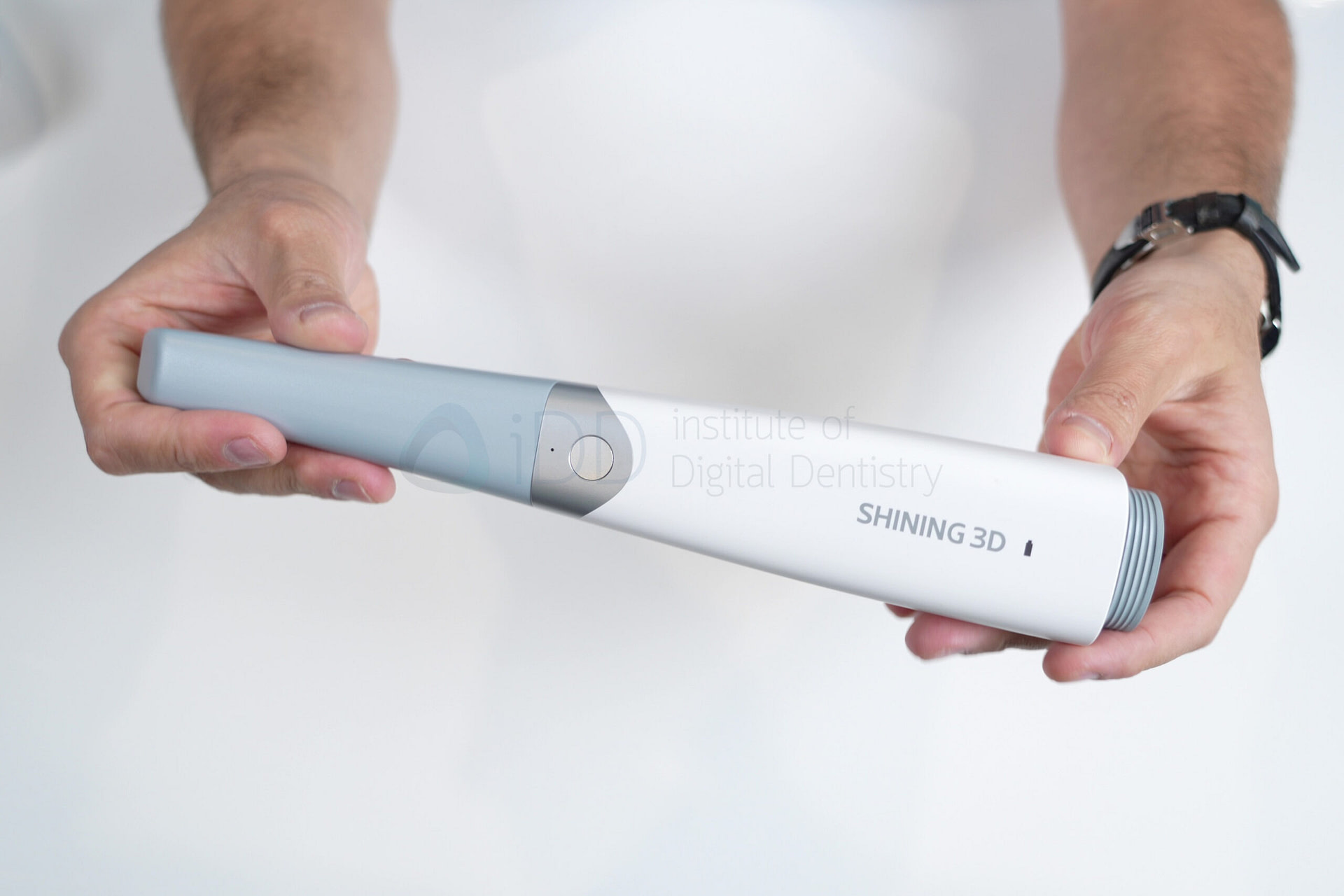
Aoralscan 3 Wireless Intraoral Scanner
Considering scan speed alone, it competes with much more expensive scanners on the market, such as Medit, TRIOS, iTero, etc. This scanner has impressive scan speeds especially in light of its low cost, but this is becoming a market norm. All new scanners are fast now. I routinely have used the scanner for all indications and can scan full arches with it within 35 seconds.
Anyone familiar with typical IOS scan strategies will be able to use this scanner. It is all the same strategy. It is equipped with intelligent algorithms to make the scanning process enjoyable. Soft tissue is removed automatically and accurately, and bite registrations are fast. The scanner quickly finds its place again when the scan is paused and restarted.

Aoralscan 3 scan image
One interesting thing about the Aoralscan 3 is that the image fabricated by the software has a hyper-realistic appearance to it. In fact when I share images of different scans on my socials, I commonly get told that Aoralscan 3 scans look like photos. It seems to be something dentists like in polls we run.
The scan workflow is efficient. There are no loading screens between each scan stage during the scanning workflow, making the workflow fast and efficient. Instead, the majority of the processing occurs after all scans are completed.
The software is also quite user-friendly with many scanning tips and instructions being presented on screen. This would be very handy for beginners.
Aoralscan 3 Wireless Scanner Size & Ergonomics
The Aoralscan 3 Wireless is the same as the previous generation wired scanner but slightly wider and heavier due to the batteries and wireless tech.
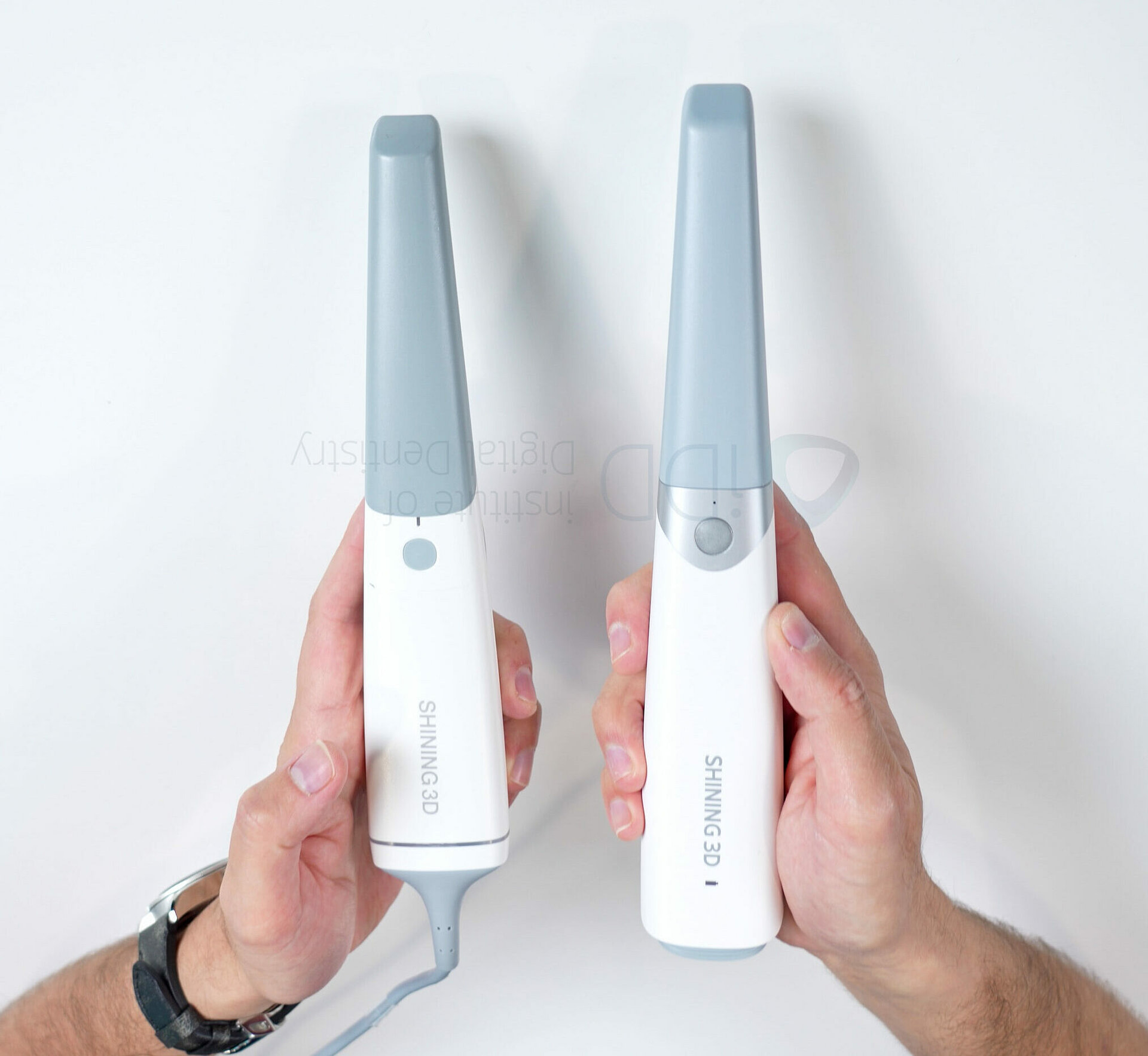
Aoralscan 3 and Aoralscan 3 Wireless side-by-side
The wireless version weighs 330 grams +/- 20 grams for the battery while the wired version weighs around 240 grams. The same and size is almost identicle between the two, with the biggest difference being the wireless version is 15mm wider.
For reference, the weights of other wireless scanners are
- Medit i700 Wireless - 328 grams
- TRIOS 5 - 375 grams
- AS 200e - 245 grams
So, the Aoralscan 3 wireless is in line with the others but not as lightweight as the AS 200e.
Although it is heavier than its predecessor, the scanner still feels really ergonomic. It fits comfortably in the hand and has a narrow scanning tip that makes it good to scan tight to reach areas with. It has to be said though, that the scanning tip FOV is smaller than other scanners these days like i900, TRIOS 5 etc.
The exact dimension of the scanner is 270±3 (L) x 50±3 (W) x 40±3 (H) mm (includes the battery and scanning tip)
Aoralscan 3 Wireless Scanner Tips
Inside the box, you will find the same inclusions as the non-wireless version. The scanner comes with five scanning tips that are not reversible and only fit one way.
Four of these scanning tips are the 'adult' size, and one scanning tip is 'child' size. The scanning tip sizes are as follows:
- Adult size - 16 mm × 12 mm
- Child size - 12 mm × 9 mm
This uses the same exact tips as the non-wired version. For reference the TRIOS 5 scanner tip dimension is 19mm x 13mm and the new i900 large tips are 26.9 mm x 19.7 mm. A protective cap for the scanner is also included when a scanning tip is not being used.
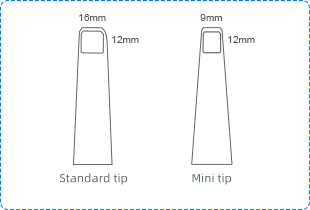
Dual-size Tips: Adult and Pediatric
The Aoralscan 3 scanner tips are quite long. This extended length scanner head is said to be specifically designed by the company in order to avoid the operator’s fingers touching the inside patient’s mouth, avoiding any artefacts of capturing the fingers. As mentioned, I did find them quite useful to reach tight to scan areas, like distal of the terminal molars. But they do have a relatively small FOV, which means it can take longer to scan.
The Aoralscan 3 Wireless only has one button to start and stop scanning and a a LED ring at the base of the scanner and a small LED just above the scanning button. These give the user visual feedback about the status of the scanner, as follows:
- Green 'Breathing' (fading out and lighting up) color when plugged in and on stand-by mode
- Constant Green color when connected to the software and scanning is taking place
- Blue color when the scanner has lost its place during scanning
The scanner has some excellent added benefits, such as a remote-control function built into the scanner using a motion detector, similar to Medit and TRIOS. This feature enables you to navigate the entire software without touching the computer. Double click the scanner button to progress through the workflow (jaw scans) or click and hold the button, and a menu pops up with four options - next, back, delete or view the model. You chose your option by waving the scanner in one of four directions.
The scanner comes with a fabric travel case like a hard-shell suitcase, branded with the Shining 3D logo on the front. These travel cases have become standard with most intraoral scanners and can be used to transport the scanner around.
Lastly, there is also a dedicated cart solution designed and sold by Shining 3D. I have been using this with my scanner laptop for over a year and I have to say, it is my favorite cart from any scanner company, and much better than most of the cheap computer carts on wheels you can get from amazon.
The cart is made of metal, looks medical and aesthetic, and is fit for purpose – a single shelve for your computer laptop and a holder for the scanner. Plus, one drawer for the scanner tips etc. I really like this cart and would recommend it to anyone with any intraoral scanner.
Aoralscan 3 Wireless Technology
The Aoralscan 3 Wireless uses batteries just like TRIOS 5 or Medit i700 wireless. These can be easily removed and inserted at the base of the scanner. They click into place and are firm. I never had an issue with them falling out or anything like that.
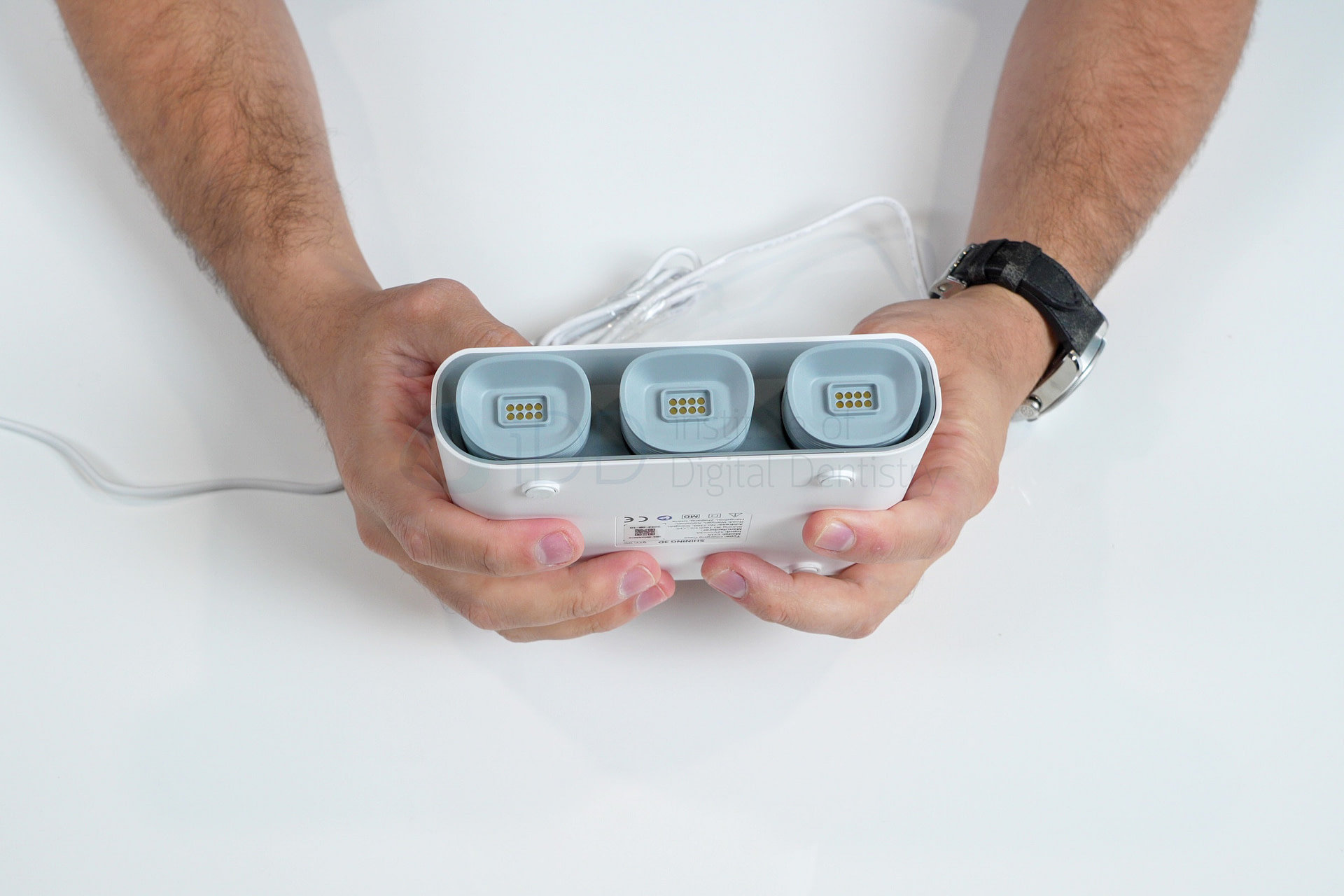
Aoralscan 3 Wireless Batteries x3.
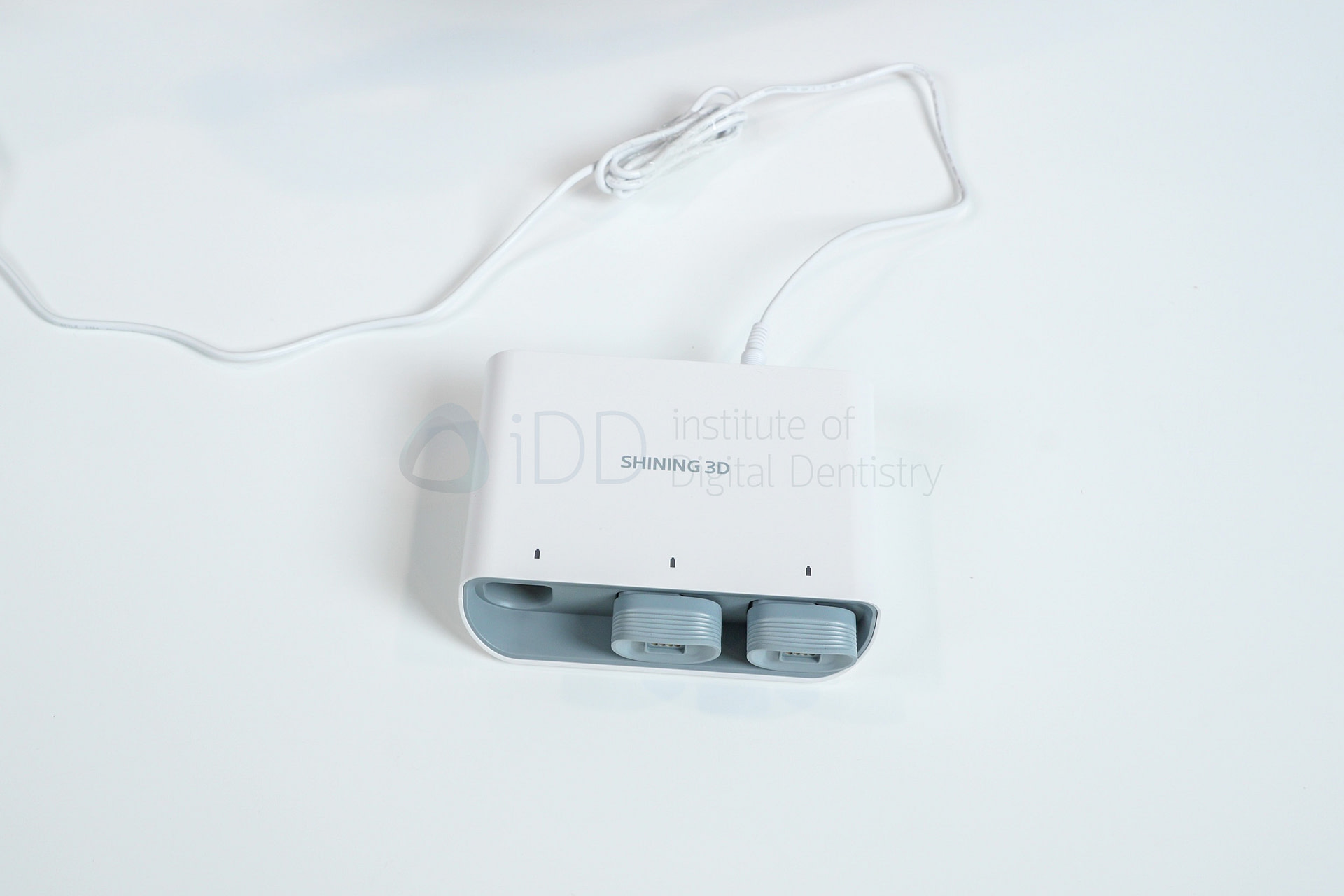
Aoralscan 3 Wireless Battery charging dock
The company provides you with 3 batteries inside the box and a battery charger. Once again, similar to the battery chargers from Medit or TRIOS. This is plugged into the wall and 3 batteries at the same time can be charged.
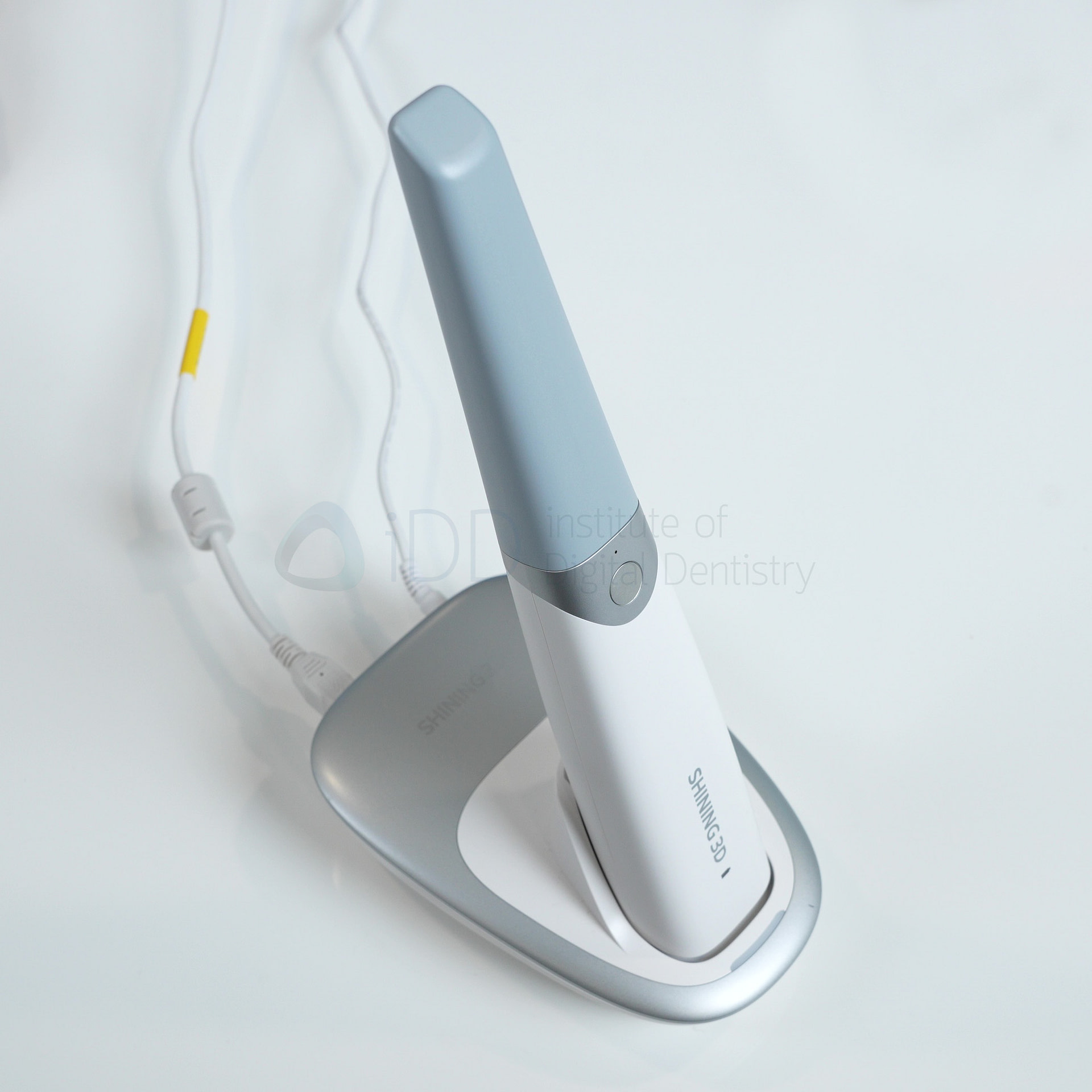
Aoralscan 3 Wireless scanner docked on the base
Unlike Medit and TRIOS, which use a separate wireless adapter or TP-Link Dongle for the wireless connection, the Aoralscan 3 wireless has a scanner cradle that doubles as the wireless connector. It utilizes WIFI 6 technology, and I found it easy to connect the scanner to the software as long as the cradle is plugged in.
What is also good about this cradle, is that it also charges the batteries. Similar to the scanner cradle of the AS 200E. So that as long as the scanner is not in use and in its cradle, the batteries in the scanner should be charged.
You get the best of both worlds – battery charging cradle and separate battery charging station.
Each battery lasts for 2 hours of continuous scanning and 10 days in sleep mode. Given that any time you are not using it, the cradle is charging the battery, I never really found myself running out of battery power. It is a nice design.
Lastly, the software manages both wireless and wired versions of the scanner on the same computer very well. There is a toggle between them which makes changing between wired and wireless versions of the same scanner very easy, if you needed to for whatever reason.
Aoralscan 3 Inbuilt Fan
The Aoralscan 3 IOS has an inbuilt fan in the scanner to prevent fogging. It makes it much easier to scan in the mouth without condensation issues on the scanner tip.
The inbuilt fan in the previous wired version was OK, but required about 1-2 minutes to warm up completely. Not really that efficient or up to the market standard these days.
Thankfully, the company actually improved this in the new wireless version. Within 30-40 seconds the scanner is ready to use from being completely cold and turned off. I am glad the company addressed this.
Although inbuilt fans are standard with most scanners, some we have tested struggle even after extended periods of warm-up time. We have found that the Aoralscan 3 Wireless fan works well, and no complaints here.
Aoralscan 3 Wireless Full Arch Scanning
The Aoralscan 3 handles full-arch scans very well. On scanning speed and flow alone, this scanner can compete with much more expensive IOS on the market.
It has an impressive scan speed, impressive AI, picks up when it is stopped quickly, and an inbuilt fan that prevents fogging and enables long periods of uninterrupted scanning. It is used with a similar scanning protocol as all other scanners.
Using the Aoralscan 3 Wireless, we could carry out full arch scans within 30-35 seconds. We tested full arches, quadrants, metals, and edentulous areas, and it did a good job regardless.
The wireless did not impact this at all, and it works comparatively to the wired version.

Full arch scan using the Aoralscan 3 Wireless
Aoralscan 3 Wireless Accuracy
Regarding accuracy, no research exists about the Aoralscan 3 Wireless, which can be said about most new scanners. The technology is simply outpacing research. We have personally used the scanner to fabricate crown and bridge restorations within our clinic with no problem.
We test all scanners on the market and compare scans of the same tooth preparation using multiple different scanners. We could not see a significant deviation when comparing scans taken using the Aoralscan 3Wireless to other IOS devices and even a lab scanner (using Geomagic Control or Medit compares software).
However, there is a clear difference in the detail of the rendered colour scan detail. The scans from the Aoralscan 3 Wireless are a little less detailed when using normal mode. Not the worst colour scan render we have seen, but not the highest resolution. Somewhere in the middle, you can see this in the images below. This can be improved if you use the HD mode.
Overall, the Aoralscan 3 scanner performs very well for various indications from single crowns, implant scans, edentulous sites, and deep preps. We had no issues. It also has a 22mm scan depth which can be useful scanning narrow or deep spaces.
I will say that for edentulous scanning new users may find this more difficult than something like the TRIOS 5, which still seems to be the best at edentulous scanning. This is partly because of the smaller FOV of the shining Aoralscan 3 Wireless and thus if you have poor strategy, you can introduce more errors with edentulous scans. But it is doable.
By the way, we have a free intraoral scanning course in our Free Academy that teaches you about optimal scan strategies. Click here to check it out.
Using the scanner properly and controlling the scanning field correctly will result in a good scan. Poor usage will result in poor scans. Just like any other scanner, the operator is the key.
One nice workflow feature we liked was that as soon as you finish your bite registration (which is very quickly aligned by the software), the scanner automatically shows you a heat map of the occlusion straight away without having to click into a menu. It is just instant as soon as bite registration is complete. This makes a lot of sense and is a great workflow improvement over standard.
Final processing of full-arch scans takes about 1-2 minutes. It has been greatly optimized compared to when we reviewed the wired version over a year ago. And yes, I am using the same computer as back then, my trusty AERO 16 HDR. It is great to see an improvement here.
Aoralscan 3 Wireless Calibration
The Aoralscan 3 Wireless has the same calibration tool as the previous scanner. And it is one of the largest calibration tools I have ever seen.
Unlike other calibration devices, you do not have to manually do anything. Insert the scanner (with no scanning tip) into the calibration tool, and the rest is automated. This calibration tool also needs to be plugged into the computer by USB. It uses power from the USB to automate the process. Sounds good on paper.
But calibration takes a long time, around 5 minutes when we timed it. That is not a big deal if calibration is done routinely at the start of the day, for instance, but it will be a gruelling wait if you need to calibrate while the patient is in the chair. Thankfully, you can still scan if it is overdue for calibration. Calibration usually needs to be done every 2-3 weeks, and the software does a great job of reminding you.
One other unique feature is a 'brightness' calibration. This is thankfully much faster than the standard calibration, and I can only assume it controls the exposure setting / ISO of the sensor. As generally, the images of the Aoralscan 3 Wireless look very bright.
Although many scanners are 'calibration-free' these days, the benefit of not needing a calibration tool is that the user does not have to worry about calibrating the scanner before cases. The downside is that the user will not know if scanner accuracy is optimal and whether the scanner is performing correctly.
Calibration is easy to carry out with many prompts on the screen.
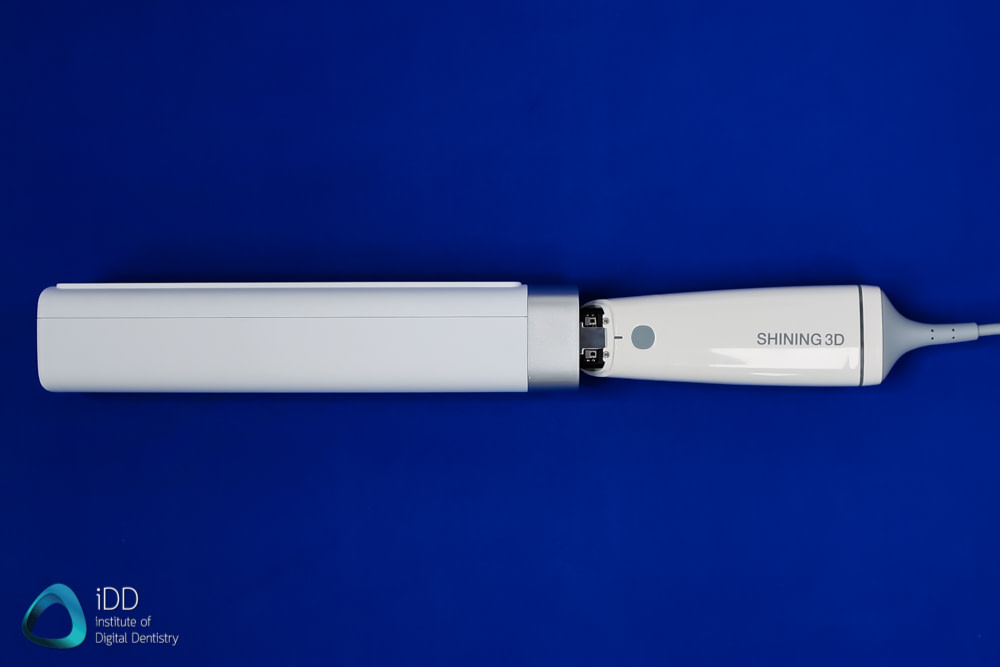
Shining 3D Aoralscan 3 Wireless Software
The software that runs the Aoralscan 3 Wirelessis called Dental Launcher. You can install the software by running the application inside the USB with the scanner.
This is one of the best parts of the entire scanner because as mentioned, the Aoralscan 3 software is easily the best out of all Chinese scanners tested by iDD. It is better than most scanners on the market, for that matter. And it keeps getting better with massive improvements over the past 12 months.

The software is modern-looking, easy to use, simplified, aesthetic, and loaded with excellent features. Chinese scanners are catching up on software to the main leaders in the market like 3Shape, Medit, iTero etc.
All the essential scanner software functions such as analyzing occlusion or reduction space, editing scans, removing any scan data, undercut analysis, margin line placement, scan coordinate adjustment etc., are all present in the software.
More importantly, it has workflows inbuilt for basically all indications. Scanning crowns, scanning implant scan bodies, scanning edentulous cases, including copy full denture and wax rim scans, etc. You can also add additional scan data on any patient case and multiple jaw relation bites. These features were created and popularized by Medit, and frankly every scanner should have them, so it is nice to see here too.
It also has extra features not commonly seen in other low-cost scanners, like a full suite of scanner apps like model builders, smile design, ortho simulators, and some CAD software.

All these features work well enough and are all free. It is very impressive for an affordable intraoral scanner. More on the apps below.
Shining 3D also provides a fully-fledged cloud-based storage and sending of scans. You can send cases to anyone who has an Aoralscan 3 Cloud account. When using the workflow, everything is stored locally, and it is up to you to move it to the cloud manually. The cloud service is currently free.
Aoralscan 3 Wireless Scanner Apps
Orthodontic Simulation
An orthodontic simulator can be found within Shining 3D software and is called ConsulOS.
As you may already know, Ortho Simulators create an orthodontic alignment animation after you have taken full arch scans. You can find these simulators in Carestream Dental, Medit, TRIOS, and iTero scanners.
Ortho simulators are a communication tool that is used to improve patient case acceptance and also patient communication. The Shining 3D version works well works well and is highly automated with accurate automatic teeth segmentation.

The tooth setups (all done by the AI) are good enough for the most part, but sometimes need adjustment. Don’t forget this is just a treatment simulator and you need to be careful that the results are actually achievable.
Typically, these simulators can be a little hit and miss, with some creating really ugly proposals, but the Shining 3D version seems to do pretty well. The entire workflow is easy and intuitive only requiring a few clicks. This is by far their best app in the software I feel.
I was most impressed by the tooth setup carried out automatically as the AI aligned the teeth. The Orthodontic Simulator includes automatic segmentation of all the teeth, which is done close to perfect every time we tested it. It even picks up missing teeth correctly, and any refinements needed are done easily including adding IPR.
The software also allows you to show what traditional braces would look like on the teeth. Which I thought was a really cool spin on these orthodontic simulators – not just showing teeth movements.
One last thing that is really cool and unique to Shining 3D, is that when paired with their face scanner, the MetiSmile, you can combine all these data sets together and the ortho simulator will also make changes to the mid face via the software as the teeth move. It is something that is quite incredible for any scanner on the market to have this sort of feature, let alone one of the most affordable.
Invisalign users note: for those of you who provide Invisalign treatment for your patients, Align will NOT accept Aoralscan 3 scans for Invisalign treatment. You will need to consider other aligner options. This is no reflection of the scanner itself.
Aoralscan 3 Wireless Model Builder aka AccuDesign
The Aoralscan 3 Model Builder app is another great addition to the software.
It allows you to quickly and easily design printable 3D models from your scans within a few clicks. It is pretty fitting for a company that also sells 3D printers, and with the rise of 3D printing we are seeing this sort of application more and more with intraoral scanners.
Although not a unique software to Shining 3D Aoralscan 3 as a model builder application comes with many scanners such as Medit, 3Shape, and Dexis scanners, it is nice to see Shining 3D keep up with the competition. Especially when it is more affordable too.
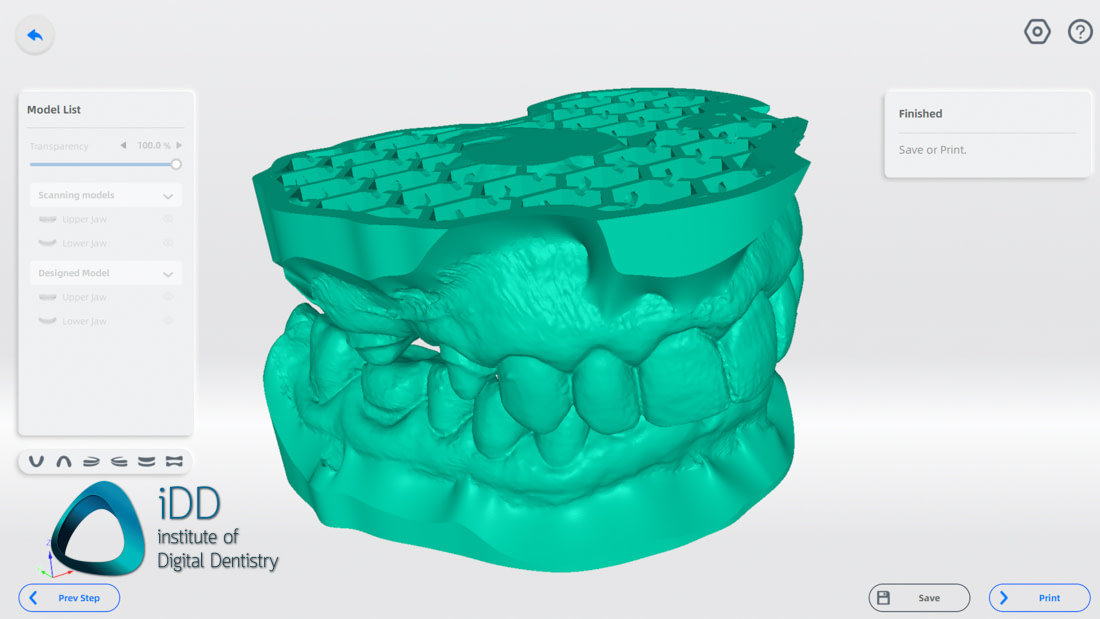
This Model Builder software is easy to use. Again, mainly driven by AI. Within 2-3 clicks, you can have a printable model. Shining 3D seems to have taken some inspiration from Medit, as they have created a software with the some of the same strengths. The model building process is very streamlined and gives you several options for your bases. You can easily choose the thickness and height, hollow or solid, drain holes or not, add text, etc. It is an impressive software addition. Although it is not quite fully fedged as the Medit model builder which remains the gold standard, it is still a decent piece of software.
Chinese scanners have caught up in scanning speed, but most do not compete on software. This is changing. The Shining 3D software is missing only a smile design software to have a complete line-up. It is impressive to see these software apps done so well in a low-cost Chinese intraoral scanner.
Aoralscan 3 Wireless Patient Tracking App MetronTrack
Compared to last year when we reviewed the wired version of the Aoralscan 3 we now have some new apps. For one, a patient tracking app called MetronTrack.
This is simple and is the similar to TRIOS and iTero patient tracking software. The idea is that this is comparison tool designed to effectively manage the monitoring of patients’ oral changes throughout the treatment process by allowing you to compare different data (scan) sets. It also has some really cool measurement tools.
When taking different scans for the same patient, you can overlay these and show the patient the changes. This may be an ortho case, or a wear case with the patient coming in every year for an examination and slowly wearing their teeth further.
It is a really cool app and well designed with a range of different tools for making comparisons. Nice to see.
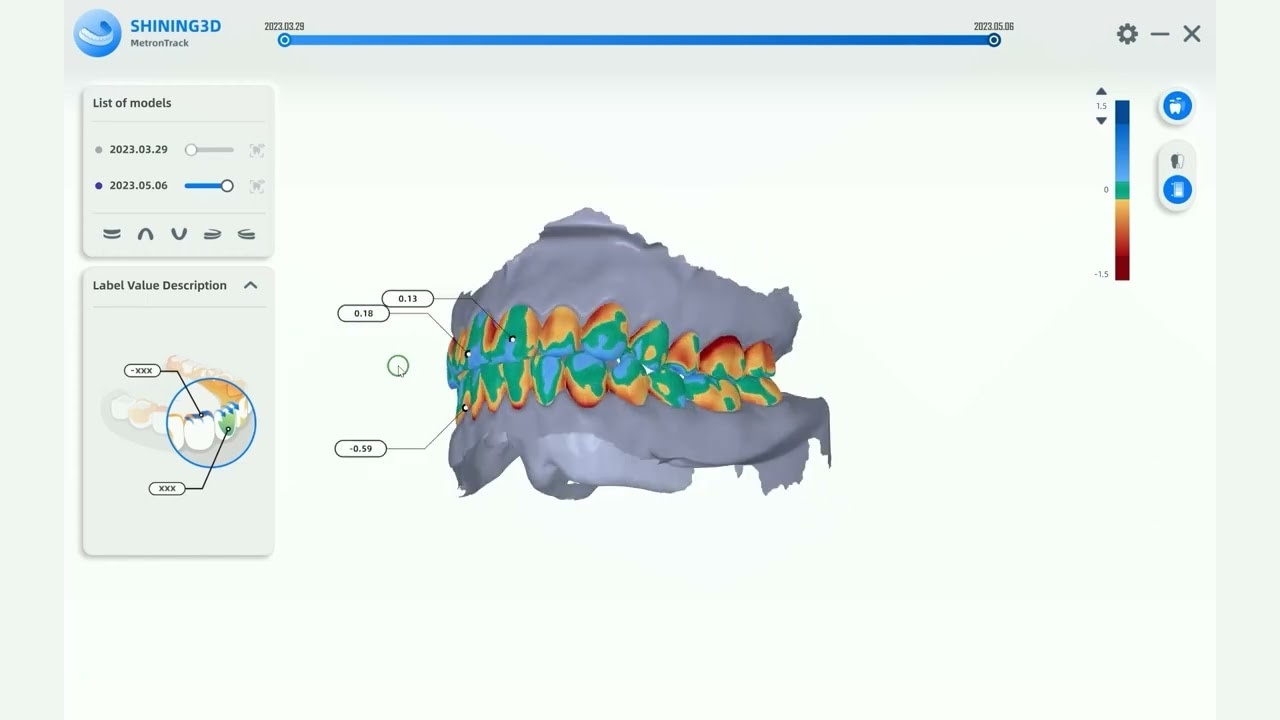
Aoralscan 3 Wireless Patient Reporting App ConsulReport
Another new feature is what the company calls ConsulReport. This is a feature that was started by Chinese intraoral scanners and becoming more popular, even recently seen in Medit.
With ConsulReport, an oral health report can be automatically generated for the patient after scanning. The entire idea of this, is that scanners are viewed as not just an impression replacement device, but a device to be used in the patient examination.
What's cool about this app is that with minimal modification or input, the AI will detect certain oral health conditions from the scans and make these into a report. You can also add your own annotations and notes, for example, leaky fillings, carious lesions, tartar deposits etc.
It is a neat feature to see and again, done well by the Shining 3D software.
Aoralscan 3 Wireless CAD Features
Then we have the new CAD features the company has been developing. Many intraoral scanner companies are blurring the lines of what a scanner software does and what a CAD software does. Especially with the rise of 3D printing which is making in-house manufacturing even more accessible.
First, we have what the company calls CreSplint. This is a software that is a one-click-solution to design night guards to automatically, using AI. It works OK. Not the best splint designs I have seen, and they are mostly flat planned scalloped splints, but it is cool, and free. I think whats more interesting is that this is being developed and as long as the company improves it, it could be a really powerful tool.

Next, we have CreIBT – this is another AI software workflow to design indirect bonding trays, which can be directly 3D printed. This is more for the ortho crowd and different types of brackets can be uploaded, placed on the teeth as required and then a IBT is designed. Another neat feature.
Lastly, we have CreTemp – this allows you to design a crown once again mostly automated. Kind of like Medit Design but less features, first you place the margin line and then a crown can be designed which then can be exported and printed in house. This I feel needs the most work. It is a very rudimentary software. Does the job but it is fiddly and a bit time consuming. No where near as simple as the other software in the line-up that only require 1-2 clicks. Although again, nice to see the company develop this and include it in the software.

It is very interesting to see Shining develop their CAD tools. The only other scanner on the entire market that offers this sort of thing for free is Medit. Great to see Chinese IOS starting to catch up.
Aoralscan 3 Wireless Ease of Use
As with almost every scanner on the market these days, the Aoralscan software does very well in making the workflow straightforward. Ease of use comes from the software that supports the hardware. Overall, the entire software has a level of polish you don't typically see in Chinese products and is well thought out.
Everything works very well, from creating cases and sending them to the multiple scanner apps. The software that runs the Aoralscan 3 Wireless is fantastic and nice to see in an economical product.
When using the scanner daily, the workflow is intuitive. It follows a simple step-by-step progression that is identical across almost every scanner on the market.
The typical workflow is as follows:
- Filling out the patient details and order form
- Scanning the preparation
- Scanning the opposing teeth
- Scanning the bite
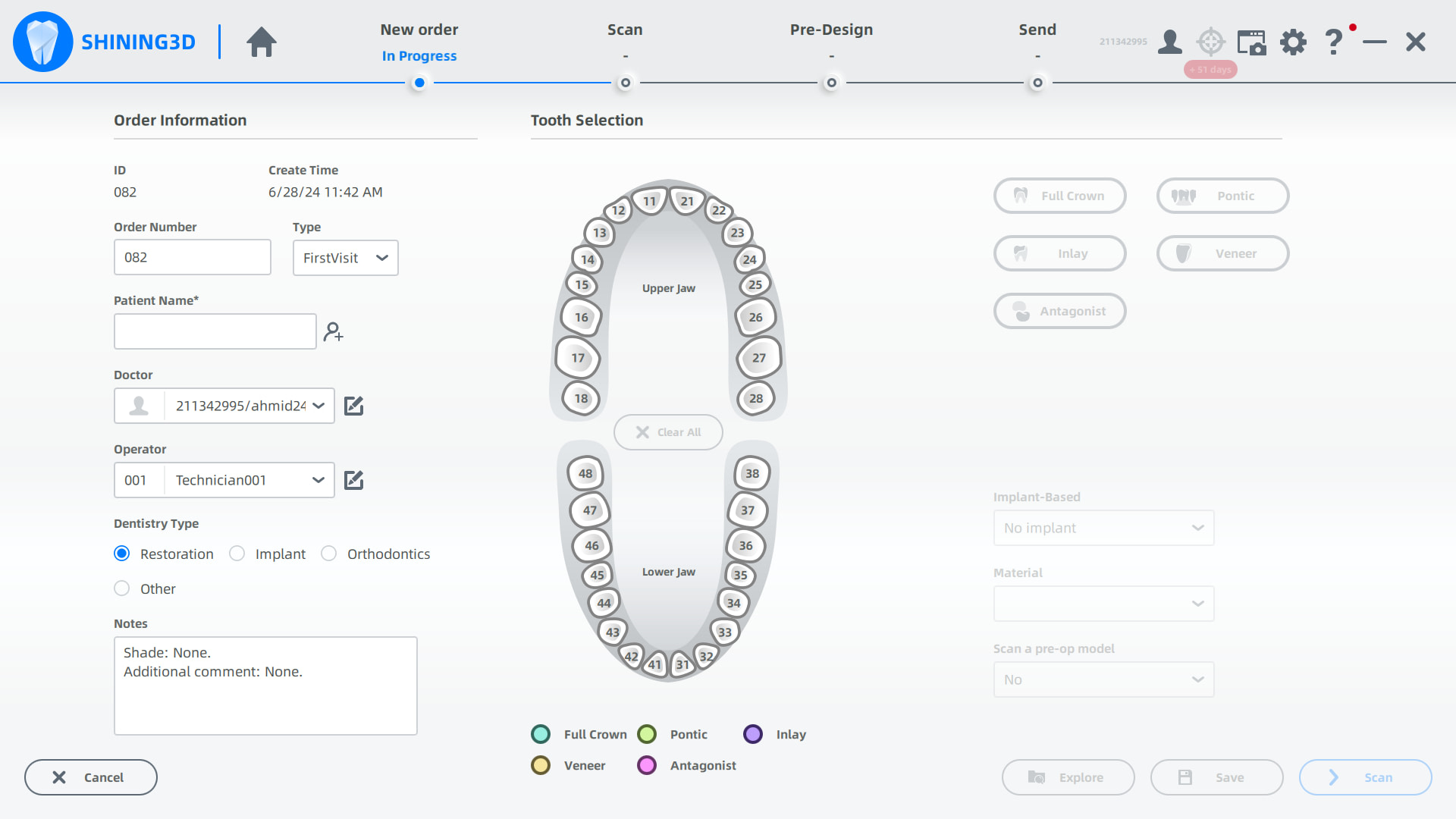
As mentioned, it has all the right tools and features for day-to-day use. Workflows for all indications are here including denture workflows and all on x. It also has exocad exporting capabilities.
Overall, the software user interface is modern and works well. It is a very impressive Chinese product and a low-cost offering. This software is easily in the top 5 scanners on the market, and it does a lot of things right.
Open or Closed Architecture
The Aoralscan 3 is an open scanner, and the software enables easy exporting of scans in multiple different formats. This includes STL but also PLY, OBJ, and exocad file types.
You will primarily use STL, the most widely accepted scanning format across labs and software. One key distinction is that the STL file is NOT a color file. Although the scanner scans in color, you will be designing on a monochrome model when exporting in STL and opening in design software.
PLY or OBJ files include color details, and it is great to see this being offered as an export option. The software makes exporting scans straightforward from both the software and the cloud.
Exporting of scans in multiple different file types is done automatically once the case is completed. This is stored locally with several additional files, as shown below.
Shining 3D Aoralscan 3 Price
The Aoralscan 3 Wireless scanner is the most affordable wireless scanner on the market at a RRP $ 14,000 USD. Note the wired version of the exact same scanner is around $11,000 USD, so three thousand dollars more for the luxury of wireless technology.
Note - the retail price may vary slightly according to local tax policies and other factors, so check with your local distributor or reseller.
At this price point, the Aoralscan 3 Wireless is mid-tier priced scanner. Although 2-3 years ago this would be considered enter level at 14k USD and one of the most affordable IOS on the market, now the market has shifted, and we are seeing more and more scanning released at this price point.
However, it is still the most affordable wireless IOS and given the software, for what you get, it is pretty darn impressive.
An ongoing cost you need to consider is the scanning heads. Aoralscan 3 Wireless has removable and autoclavable scanning heads, which provide ideal cross-infection control. This feature has become the norm across the entire IOS market.
The autoclavable scanning heads have a limit of 100 autoclave cycles at 134 degrees Celsius, after which they will need to be replaced. Scanning heads are sold individually at $45 USD each ($0.45 USD per patient).
Lastly, make sure you buy a computer/laptop with sufficient specs. The current recommended specs for this scanner are:
- Processor: Intel Core i7-8700 or higher
- Memory: 16GB or more
- Hard drive: 256 GB SSD or above
- Graphics card: NVIDIA ® RTX 2060 6GB DDR3 or higher
- Others: More than two Type-A USB 3.0 (or higher) ports
- Operating system: Windows 10 Professional (64-bit) or later versions of Windows operating systems
- Optional: Touch screen
Aoralscan 3 Yearly Fees / Subscription
The Aoralscan 3 has no yearly fees or subscription costs.
The omission of subscription/yearly fees is becoming increasingly common in the IOS market. Low cost and subscription-free are how these Chinese scanners will penetrate the market.
Aoralscan 3 has a decent cloud storage service with the scanner. Surprisingly, it also is free. Who knows if this stays like this forever, however.
So absolutely no ongoing fees for using the scanner itself, only the scanner heads.
Aoralscan 3 Wireless Review Rating
Evaluation Ratings
Scanning Speed
Scanning Flow
Scanner Size
Ease of Use
Scanner Software
Investment Cost
Additional Features
Connectivity
Wireless and Charging Base
Wireless Scanner
Scanner cradle has WiFi 6
Caries Detection
Software Apps
ConsulOS, ConsulReport, MetronTrack, AccuDesign (Models)
CAD/CAM Software
Basic CAD Apps for Splint, Temp, IBT
Subscription
Requirements
No scanner yearly fees. Free cloud storage with no storage limit.
Autoclavable Tips
100 times per tip
Conclusion
In summary, this is our in-depth review of the Aoralscan 3 Wireless intraoral scanner by Shining 3D.
Overall, the Aoralscan 3 is impressive. Whether it is wired or wireless both scanners are high performing scanner on this market.
The Aoralscan 3 Wireless is essentially exactly the same as the wired version but with a better heating system for the scanning tips. Being wireless means that the scanner is 30 grams heavier than the wired counterpart and slightly bigger. However, it is still ergonomic
The scanner comes in at a RRP of 14,000 USD. This makes it the most affordable wireless scanner on the market and no doubt a scanner you should look into if wireless is important for you.
Although we reviewed the wired version over a year ago, in that time Shining 3D has been very busy with updating their software. We now have an entire suite of scanner apps including model builder, ortho simulation, patient reports, patient tracking and now CAD design features too for splints, IBT and single unit crowns.
The scanner performance alone is impressive. It is fast and smooth to scan with. The software has a level of polish and usability not commonly seen in the low-cost end of the market.
Really the only concern with this scanner is that when compared directly with TRIOS and Medit, their software tends to be a little more polished and have a few more features. But it is getting very close. And the Shining 3D Aoralscan 3 Wireless is notably cheaper.
One other unique strength that Shining 3D has is that it is the only company in digital dentistry that also produces a 3D printer and Face Scanner (which are both quite good). The synergy between its entire workflow now with the rise of 3D printing, may give this company a significant edge in the future.
The scanner market is heating up. For those who want an economical but high performing scanner than Aoralscan 3 is a scanner I can easily recommend. If you want wireless, you will pay three thousand more for that luxury.
Anyone who is considering buying this, I would recommend going to tradeshows and trying it. Or ask your local rep for a trial unit. Only then will you really know if this is the right scanner for you.
If there is anything we did not cover or have a question, please leave a comment below.

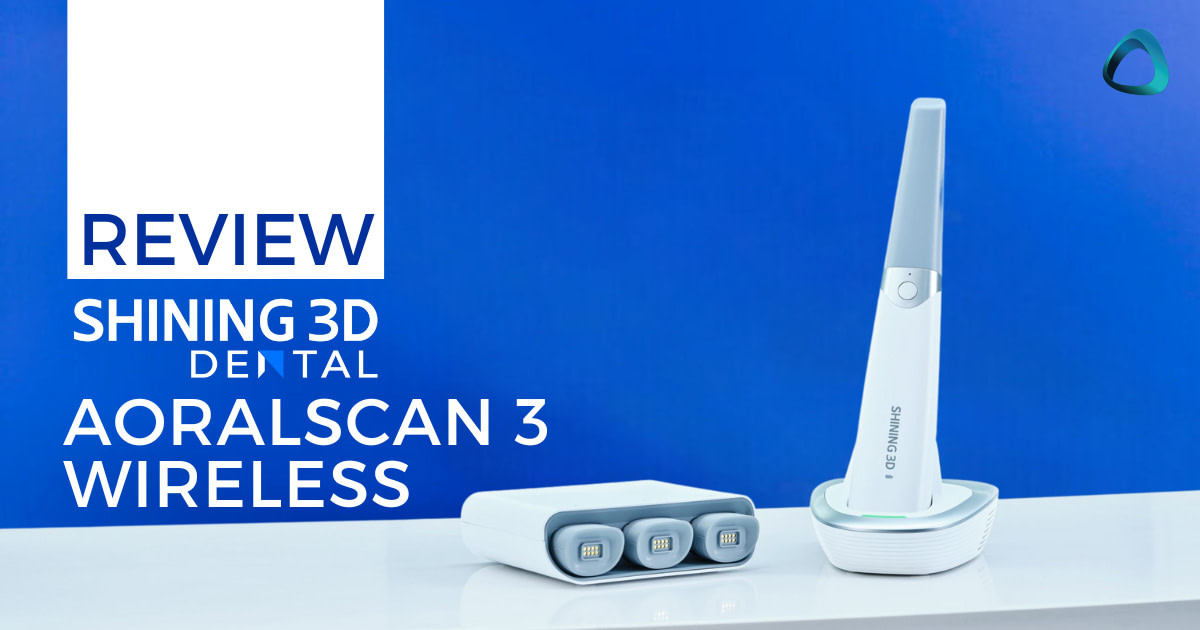

I want to buy Shining 3D, is it better wireless or wired?
Totally up to personal preference. They work the same way.
Wired = lighter and smaller
Wireless = wireless but heavier.